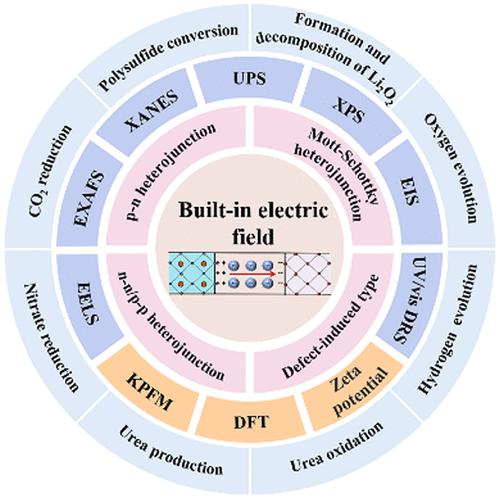Our official English website, www.x-mol.net, welcomes your
feedback! (Note: you will need to create a separate account there.)
Designing a Built-In Electric Field for Efficient Energy Electrocatalysis
ACS Nano ( IF 15.8 ) Pub Date : 2022-12-15 , DOI: 10.1021/acsnano.2c09888 Xin Zhao 1 , Mengjie Liu 1 , Yuchao Wang 1 , Yu Xiong 2 , Peiyao Yang 1 , Jiaqian Qin 3 , Xiang Xiong 1 , Yongpeng Lei 1
ACS Nano ( IF 15.8 ) Pub Date : 2022-12-15 , DOI: 10.1021/acsnano.2c09888 Xin Zhao 1 , Mengjie Liu 1 , Yuchao Wang 1 , Yu Xiong 2 , Peiyao Yang 1 , Jiaqian Qin 3 , Xiang Xiong 1 , Yongpeng Lei 1
Affiliation

|
To utilize intermittent renewable energy as well as achieve the goals of peak carbon dioxide emissions and carbon neutrality, various electrocatalytic devices have been developed. However, the electrocatalytic reactions, e.g., hydrogen evolution reaction/oxygen evolution reaction in overall water splitting, polysulfide conversion in lithium–sulfur batteries, formation/decomposition of lithium peroxide in lithium–oxygen batteries, and nitrate reduction reaction to degrade sewage, suffer from sluggish kinetics caused by multielectron transfer processes. Owing to the merits of accelerated charge transport, optimized adsorption/desorption of intermediates, raised conductivity, regulation of the reaction microenvironment, as well as ease to combine with geometric characteristics, the built-in electric field (BIEF) is expected to overcome the above problems. Here, we give a Review about the very recent progress of BIEF for efficient energy electrocatalysis. First, the construction strategies and the characterization methods (qualitative and quantitative analysis) of BIEF are summarized. Then, the up-to-date overviews of BIEF engineering in electrocatalysis, with attention on the electron structure optimization and reaction microenvironment modulation, are analyzed and discussed in detail. In the end, the challenges and perspectives of BIEF engineering are proposed. This Review gives a deep understanding on the design of electrocatalysts with BIEF for next-generation energy storage and electrocatalytic devices.
中文翻译:

设计用于高效能量电催化的内置电场
为了利用间歇性可再生能源并实现二氧化碳峰值排放和碳中和的目标,已经开发了各种电催化装置。然而,电催化反应,如全水分解中的析氢反应/析氧反应、锂硫电池中的多硫化物转化、锂氧电池中过氧化锂的形成/分解、以及降解污水的硝酸盐还原反应等,都存在一些问题。由多电子转移过程引起的缓慢动力学。由于具有加速电荷传输、优化中间体吸附/解吸、提高电导率、调节反应微环境以及易于与几何特征结合等优点,内置电场(BIEF)有望克服上述问题。在这里,我们回顾了 BIEF 在高效能源电催化方面的最新进展。首先,总结了BIEF的构建策略和表征方法(定性和定量分析)。然后,详细分析和讨论了电催化BIEF工程的最新概况,重点关注电子结构优化和反应微环境调节。最后提出了BIEF工程面临的挑战和展望。本综述对使用 BIEF 设计用于下一代储能和电催化装置的电催化剂进行了深入的了解。总结了BIEF的构建策略和表征方法(定性和定量分析)。然后,详细分析和讨论了电催化BIEF工程的最新概况,重点关注电子结构优化和反应微环境调节。最后提出了BIEF工程面临的挑战和展望。本综述对使用 BIEF 设计用于下一代储能和电催化装置的电催化剂进行了深入的了解。总结了BIEF的构建策略和表征方法(定性和定量分析)。然后,详细分析和讨论了电催化BIEF工程的最新概况,重点关注电子结构优化和反应微环境调节。最后提出了BIEF工程面临的挑战和展望。本综述对使用 BIEF 设计用于下一代储能和电催化装置的电催化剂进行了深入的了解。进行了详细的分析和讨论。最后提出了BIEF工程面临的挑战和展望。这篇综述对使用 BIEF 设计用于下一代储能和电催化装置的电催化剂进行了深入的了解。进行了详细的分析和讨论。最后提出了BIEF工程面临的挑战和展望。本综述对使用 BIEF 设计用于下一代储能和电催化装置的电催化剂进行了深入的了解。
更新日期:2022-12-15
中文翻译:

设计用于高效能量电催化的内置电场
为了利用间歇性可再生能源并实现二氧化碳峰值排放和碳中和的目标,已经开发了各种电催化装置。然而,电催化反应,如全水分解中的析氢反应/析氧反应、锂硫电池中的多硫化物转化、锂氧电池中过氧化锂的形成/分解、以及降解污水的硝酸盐还原反应等,都存在一些问题。由多电子转移过程引起的缓慢动力学。由于具有加速电荷传输、优化中间体吸附/解吸、提高电导率、调节反应微环境以及易于与几何特征结合等优点,内置电场(BIEF)有望克服上述问题。在这里,我们回顾了 BIEF 在高效能源电催化方面的最新进展。首先,总结了BIEF的构建策略和表征方法(定性和定量分析)。然后,详细分析和讨论了电催化BIEF工程的最新概况,重点关注电子结构优化和反应微环境调节。最后提出了BIEF工程面临的挑战和展望。本综述对使用 BIEF 设计用于下一代储能和电催化装置的电催化剂进行了深入的了解。总结了BIEF的构建策略和表征方法(定性和定量分析)。然后,详细分析和讨论了电催化BIEF工程的最新概况,重点关注电子结构优化和反应微环境调节。最后提出了BIEF工程面临的挑战和展望。本综述对使用 BIEF 设计用于下一代储能和电催化装置的电催化剂进行了深入的了解。总结了BIEF的构建策略和表征方法(定性和定量分析)。然后,详细分析和讨论了电催化BIEF工程的最新概况,重点关注电子结构优化和反应微环境调节。最后提出了BIEF工程面临的挑战和展望。本综述对使用 BIEF 设计用于下一代储能和电催化装置的电催化剂进行了深入的了解。进行了详细的分析和讨论。最后提出了BIEF工程面临的挑战和展望。这篇综述对使用 BIEF 设计用于下一代储能和电催化装置的电催化剂进行了深入的了解。进行了详细的分析和讨论。最后提出了BIEF工程面临的挑战和展望。本综述对使用 BIEF 设计用于下一代储能和电催化装置的电催化剂进行了深入的了解。

































 京公网安备 11010802027423号
京公网安备 11010802027423号